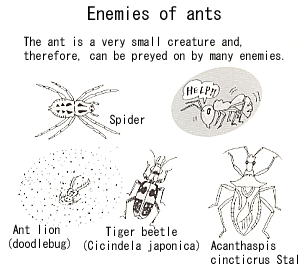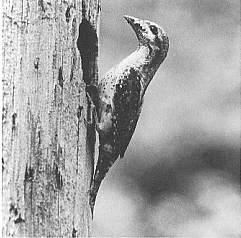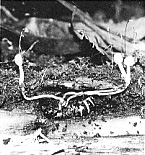|
What is the ant lion?
|
| |
|
Have you ever hear
of the ant lion (doodlebug), which is the name of an insect? The ant lion
is the larval form of the lacewing fly and one of the deadliest natural
enemies of the ant. It digs rapidly into crumbling soil and excavates a
circular pit, at the bottom of which it lies concealed awaiting some prey,
such as an ant or other insects. The ant lion seizes its prey between the
jaws and sucks its blood.
In addition to the aforementioned examples, ants have various enemies. |
|
An ant trapped in a
pit dug by an ant lion: If an ant has been trapped in such a pit, it will
never be able to creep up the wall because the wall crumbles. |
|
 |
|
|
|
 |
There are many kinds of insects
and creatures that seize ants and eat them. A typical example of such a
creature is the spider.
The bird also preys quite often on ants. Winged male and female ants flying
in search of their mating partners are often seized and consumed by birds.
In addition, the wryneck, for example, which belongs to the woodpecker family,
often seizes and eats worker ants that are moving in a procession.
The brown bear and the Asiatic black bear (moon bear) are likely to eat
ants climbing up their forelegs after they destroy ant hills (antsユ nests
which look like mounds or hills).
The ant is a very small creature and, therefore, can be preyed on by many
enemies. |
|
|
|
|
|
|
|
|
|
|
 |
The wryneck sticks its long, elastic
tongue into clefts in the bark of trees in which ants have constructed their
nests, and eat ants living in such nests. |
|
|
|
|
Ants that grow into mushrooms?
|
|
 |
Do you know that there is a fungus
that grows out from the bodies of ants? This fungus, which is called Cordyceps
japonensis Hara, produces spores that adhere to the bodies of weakened ants
and grow by taking all the nourishment from their host ants into the mushrooms.
The host ants gradually weaken and, by the time the parasitic fungi have
grown into mushrooms, the host ants die. |
|
Spores of the Cordyceps japonensis
Hara fungus adhere to the bodies of weakened ants and grow into mushrooms
by taking nourishment from their host ants. |
![]()
![]()
![]()
![]() Ant
kingdom
Ant
kingdom![]() Structures
of ants
Structures
of ants![]() Winged
ants
Winged
ants![]() Marriage
flight
Marriage
flight![]() Ant
Kingdom from a queen
Ant
Kingdom from a queen![]() Egg-laying
by a queen
Egg-laying
by a queen![]() Ants
are strong
Ants
are strong![]() Procession
of ants
Procession
of ants![]() Ants
like sweets
Ants
like sweets![]() Ants
raising insects
Ants
raising insects![]() Slave-making
ants
Slave-making
ants![]() A
fight of ants
A
fight of ants![]() Ant
lion
Ant
lion![]() Hibernation
of ants
Hibernation
of ants![]() How
to raise ants
How
to raise ants![]() Contents
Contents![]() index
index



